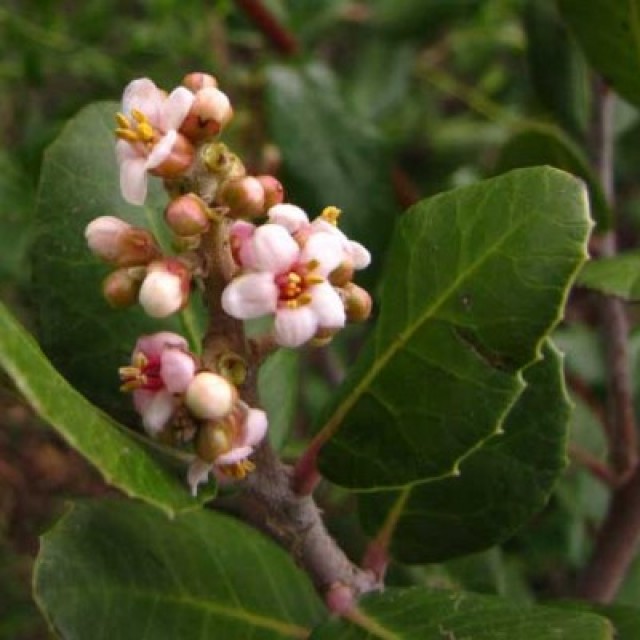COMMON NAME
Lemonadeberry
SCIENTIFIC NAME
Rhus integrifolia
ALSO KNOWN AS
Lemonade sumac
Plant family
Sumac (Anacardiaceae)
Plant group
Broadleaf Evergreens
A fragrant, rounded, thicket-forming evergreen shrub to small tree 1-6 m tall (3-20 ft). It has a stout trunk and many round smooth branches. It has shiny large round leathery evergreen leaves, and small white to pinkish flowers in dense clusters.
173 reports
93+
OBSERVERS
173+
OBSERVATIONS
Identification hints
Rhus integrifolia has flat leaves with rounded tips and should not be confused with the leaves of Rhus ovata which are generally folded along the midrib and have smooth margins and a pointed tip. The flowers also will help you distinguish these species from one another: R. integrifolia has green sepals that have tiny hairs around their edges, while R. ovata has red sepals. Laural sumac (R. laurina or Malosma laurina) can also be found at lower elevations, but is less tolerant of frost than lemonadeberry.
Did you know?
Take a close look at a flowering Lemonade berry. You will likely find a wide variety of flies, bees, and moths that like to visit its aromatic flowers. If you stay around a fruiting Lemonadeberry shrub long enough, you're also likely to see a variety of mammals and birds approach the plant to eat the fruits. The Chumash Indians soaked the bitter-sweet fruits of Lemonadeberry in water to make a sweet drink. Even though integrifolia indicates that leaves of this species tend to have smooth edges, it is very common to find lemonadeberry plants with toothed leaves! It is a popular ornamental plant, especially for waterwise gardens.
DISTRIBUTION IN TH U.S.
California
HABITAT
Lemonadeberry is found in the chaparral and coastal sage scrub communities in southern California. It is commonly found at elevations less than 2950 ft (900 m) in canyons and generally northfacing slopes in the Transverse, San Gabriel, San Bernardino, Peninsular, and San Jacinto Mountains from Santa Barbara County south to Baja California. It is particularly common on coastal bluffs. It is also found in isolated populations in the central California coastal chaparral, as well as on the Channel Islands and in Baja California.
ATTRIBUTES
Leaves
The leaves are leathery, shiny, and dark green. The simple, oval-shaped leaves range in length from 0.75 to 2.3 in (2 to 6 cm) and are 0.75 to 1.55 in (2 to 4 cm) wide. The leaves of the lemonadeberry shrub are alternately arranged on the stem with pinkish petioles 0.75 to 2.75 in (2 to 7 mm) long and have smooth to slightly toothed margins (leaf edges). The leaves sometimes have a white waxy residue on the flat upper leaf surface and a wavy margin.
Flowers
The flowers are very small and arranged in dense clusters at the tips of the branches. The flowers range from white to pinkish in color. Each flower is 0.75 to 1.55 in (2 to 4 mm) wide with small hairs along the petal edges, and can be either bisexual (having both fertile male and female reproductive parts) or can have only female reproductive parts. The flower buds are bright pink. Lemonadeberry generally blooms February to June, however blooms can be found in the autumn or early winter when rainfall (or pruning practices) permits.
Fruits
Each flower develops into a small, reddish, sticky fruit called a “drupe” that is 0.25 to 0.4 in (7 to 10 mm) in diameter. The fruit is covered with reddish-brown downy fuzz. The fruits can appear white with a waxy residue before ripening. Fruits usually mature throughout the summer.
See Menu
- 2021 Chicago Botanic Garden. All Rights Reserved.
-
Creative Commons
BY-NC-SA 4.0 - Terms of Use
- Privacy Policy
- Data Sharing and Citation Policies
- 2021 Chicago Botanic Garden. All Rights Reserved.



